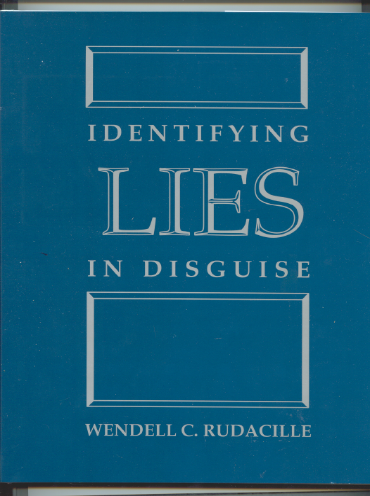IDENTIFYING LIES IN DISGUISE
Law Enforcement Guide to Detecting Deception in Verbal Behavior
Presented by Wendell C. Rudacille
$39.95 ($5.95 Shipping to U.S. Locations)
Prefer to send check or money order?
Click here for mail in order form
246 Pages
Textbook
8″ x 11″
16 Chapters
ISBN 0-7872-3780-9
“This book should be read by every police officer in the country.”
Deputy Sheriff Devon Stavrowsky,
Santa Ana CA Sheriff’s Department
“Identifying Lies In Disguise is easily understood and highly applicable to anyone who conducts interviews. Mr. Rudacille presents the material in a
manner that makes it immediately useable and simple to understand.”
Cpl. Mark D. Handler, Polygraph Examiner
Montgomery County, TX Sheriff’s Department
Chapter Titles
1. Introduction to Identifying Lies In Disguise
2. Human Language: How it Began-How it Develops
3. The Components of “Language”
4. The Language of Deception
5. Language Pragmatics and Deception
6. Memory and Lying About Memory
7. Evidence of Verbal Evasion as “Disguised Lies”
8. Sixteen Ways to Lie Without Really Lying
9. Verbs and Lying
10. Concepts of Forensic Text Analysis
11. Grammatical Clues to Lies and Truth
12. Techniques of Forensic Text Analysis
13. Analysis of Verbal Behavior During Interviews
14. The INTEXT System…A Verbal Lie Detector Test”
15. The Danger Signals of Deception During Field
Interrogations
16. Conclusion to Identifying Lies in Disguise
Appendix I — Detailed Listing of All Evasive Verbal Responses by Category
Appendix II — Guidelines & Question Formulations for Interviews & Interrogations
Appendix III — Interview Analysis Practical Exercise
Appendix IV — Quick Reference Guide to Forensic Text Analysis Criteria
References
Some of the topics in Identifying Lies In Disguise
- How to identify specific lie-related phrases used consistently by untruthful suspects, victims, and witnesses, regardless of age, race, sex, culture and language.
- The Tactics and Techniques of Deception commonly used by all untruthful interviewees.
- The 16 Theme Categories of Evasive Verbal Responses, proven by polygraph research to be linked to untruthful statements made by suspects, victims, and witnesses.
- How to identify and use suspects’ Disguised Admissions to obtain more admissions and confessions.
- How to identify suspects’ Tacit Admissions, document them, and testify about them in court.
- How to determine a Reasonable Probability of Deception or Truth based on interviewees’ responses to your questions.
- How to focus interrogations on deceptive suspects while eliminating from investigative scrutiny those who are truthful.
- How to apply incisive and effective verbal-based questioning tactics to get interviewees to provide more accurate and truthful information.
- How to examine written statements from victims, witnesses, and suspects to determine if they are providing credible information.
- FOR PATROL OFFICERS: How to identify the Danger Signals of Deception during traffic stop interviews and field interrogations.

